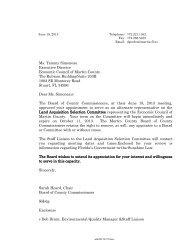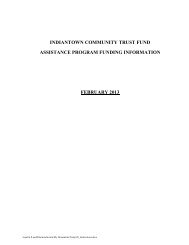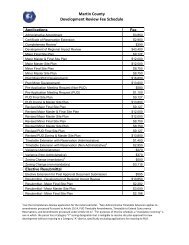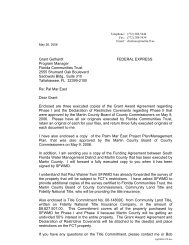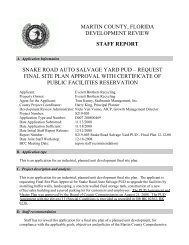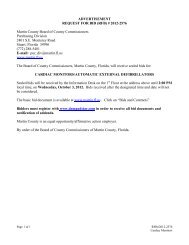minimum design & construction standards - Martin County, Florida
minimum design & construction standards - Martin County, Florida
minimum design & construction standards - Martin County, Florida
Create successful ePaper yourself
Turn your PDF publications into a flip-book with our unique Google optimized e-Paper software.
Fire Hydrants shall conform to latest AWWA Specifications C502, and shall be of the<br />
traffic-model type. Inlet connection shall be for a 6 inch pipe and main valve opening shall<br />
be a <strong>minimum</strong> of 5 1/2 inches. Hydrant bonnet shall have two 2 1/2 inch hose connections<br />
and one 4 1/2 inch pumper connection. Working pressure for hydrant shall be a <strong>minimum</strong><br />
of 150 psi. Hydrants shall be installed so that the pumper connection is perpendicular to<br />
the street. Hydrants shall be installed not more than 15 feet from the pavement (except as<br />
required by F.D.O.T.) nor in a ditch area. Hydrants shall be placed in line with the lot side<br />
lines unless otherwise approved by the Department.<br />
All working parts shall be of cast iron and high grade bronze. All hose threads shall be<br />
ANSI B26 Standard threads. The 2 1/2 inch nozzles shall have 60 degree V-threads, 7 1/2<br />
threads per inch and a 3 1/16 inch outside diameter male thread. The 4 1/2 inch nozzle<br />
shall have four threads per inch outside diameter male thread.<br />
Nozzle caps with gaskets shall be provided for all outlets to provide tight closure for<br />
nozzles. Caps shall be securely chained to barrel of hydrant. Cap nuts shall have same<br />
dimensions as operating nut of hydrant.<br />
Hydrant shall be traffic model, 3-way. All hydrants to be installed with hydrant tees, gate<br />
valve, the required lengths of 6 inch diameter ductile iron pipe (hydrant nipple), restrainer<br />
glands, 6" anchor fittings, a 6" X 36" X 36" concrete pad at bury line.<br />
Fire hydrants shall be installed with the center of the streamer nozzle 18 to 24 inches above<br />
finished grade. Hydrants shall not be placed in sidewalks. It will be the responsibility of the<br />
Developer and Contractor to move hydrants placed in the sidewalk.<br />
Hydrant barrel color to be OSHA Yellow and bonnet to be OSHA White. Drain holes shall<br />
be deleted or plugged with appropriate brass set screws.<br />
Fire hydrants shall be provided in all water mains, transmission, and distribution systems.<br />
Fire hydrants shall be spaced as required. A Fire Marshall approved plan is required with<br />
all preliminary plan submissions.<br />
All fire hydrants shall be identified with a pavement marker, Stimsonite Model C80. The<br />
marker shall be placed on the side of the street of the hydrant, four feet inside of the solid<br />
white line denoting the edge of roadway. The marker shall be installed using a two-part<br />
epoxy adhesive as manufactured by Ennis Paint Company or approved equal.<br />
Fire hydrant branches (from main to hydrant) shall be not less than 6 inches inside<br />
diameter. Each branch shall be provided with a gate valve located as close as possible to<br />
the main. Valve box top shall be set to grade. Hydrants shall be located near road lines<br />
with pumper discharge nozzle facing the roadway. Hydrants shall be laid as to minimize<br />
their vulnerability to traffic.<br />
Fire hydrant extensions shall not be allowed.<br />
11



